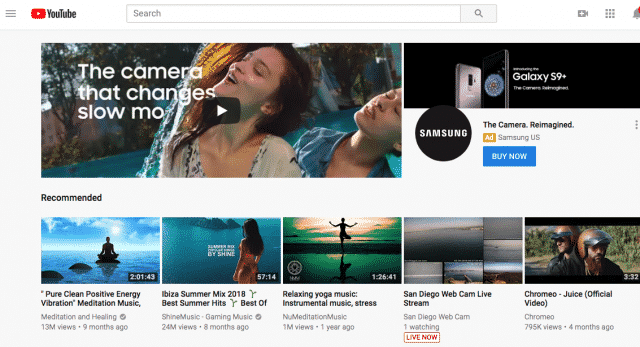For content creators, YouTube has long been a powerful the video platform you use when you want to get your message out to a large audience. With more and more creators joining each day, it’s easy to feel as though your voice can get lost in the noise.
The way to get past the idle cyber space and to be seen is to utilize YouTube analytics to its maximum potential and find the right data to inform your overall content strategy. YouTube analytics are robust, due to the platform being owned by Google, and neglecting to study them at least monthly will do you no favors in creating a successful channel.
Use your YouTube analytics, and don’t be afraid to do so. If you’re feeling a wee bit scared and overwhelmed at the idea of looking at even more metrics, here’s a few helpful tips for digesting even more metrics.
Focus on the Metrics That Matter Most
YouTube analytics can be a dream or a nightmare if you aren’t sure what metrics you should be studying. To truly get the most out of the data, these are the metrics you should be focusing on, both overall and per video:
- Views: Exactly as it sounds, how many views you are getting on your videos.
- Watch Time: How many minutes of watch time you are getting, accumatively.
- Average View Duration: How long people are watching a video before stopping.
- Traffic Sources: Where your traffic is coming from; how people are finding your videos.
Views, Watch Time, & View Duration
Your views and the data behind them are the best places to start. Views are held to a higher standard by YouTube than subscribers, although most channels tend to focus on subscriber numbers over anything else.
Subscribers mean nothing if they aren’t watching, and YouTube wants them on the platform as much as possible and for as long as possible to be served ads. So your goal should be to increase your views, and to do this you need to study which content is getting the most views consistently.
Sometimes more so than particularly great videos, it’s easier to notice which videos may be getting less than average views, as you’ll see a notable drop in your graph when that video is released. Those videos are worth taking a look at to see what you might be doing that people aren’t receptive to.
Why are they dropping off or not viewing in the first place?
That video may be wildly off topic from what subscribers are used to seeing on your channel. For example, you might usually be a tutorial channel but decided to put out a vlog. If people come to your channel and get different content than what they subscribed to, they’re likely to just pass on watching that video.
Take Note of Trending Videos
If there are specific videos doing well, consider the content, consider what the topic is. Think of how you can stretch it into several parts or create videos that drill down into one concept more deeply.
A travel business channel might find their content about solo trips is doing best, so they’ll create more content around flying solo, picking a hotel when solo, and eating at restaurants solo to piggyback off what is already popular and performing well.
After views, watch time & view duration should be your next focus. These numbers are gold in YouTube’s eyes. You’re keeping people on the platform, serving them content they actually watch for a decent period of time.
To YouTube, this means your content is worth promoting, and you’ll have an increased chance to show up on Suggested Videos and the Home page to both subscribers and non-subscribers alike.
Take Note of View Duration
View duration is an indicator of how entertaining a video might be. Take note of what is working to hold attention and what isn’t. View duration directly affects watch time, so it’s important to track.
Around 20% of viewers who start a video will stop watching after 10 seconds. Skip the long intros and get right to the point with videos to avoid this drop-off.
If you do have a decent average of a few minutes of view duration, start to study the drop-off point later on in your videos. Look at what is happening within the content.
Are you rambling? Is it too slow paced? Are you saying certain words that are potentially turning viewers away? Take note of what is happening in at least 10-15 videos when viewers stop watching and see if there is a recurring theme. Adjust your script to avoid any stalls or points of contention.
Know Where the Traffic is Coming From
Knowing where your traffic is coming from is important no matter what platform you’re on. On YouTube, there are specific traffic sources that hold more weight and equal more views.
Ideally, you want the majority of your traffic to come from browse features and suggested videos. Why is this? It means YouTube finds your content relevant and wants to make sure a larger audience is seeing it.
Dominating browse features and suggested videos is built into SEO on the platform. Your title, description, and tags are key to getting yourself suggested. You want your videos to be appearing alongside similar content so that viewers will continue their YouTube binge session by clicking on your video.
In fact, the average viewing session length on mobile is 40 minutes. You want to be a part of that 40 minutes and have metrics with that type of data.
Optimize Your Video Title and Tags
To do this, you need to very carefully choose your title and tags. YouTube is a search engine, so your keywords need to follow the long form search style that an average viewer would use. Single-word tags do not work anymore. It’s important to focus on variations of how a person may search for a topic.
If your video is focused on how to create a sales funnel, you need to think of the many ways a person might search for this, “how to create a sales funnel, creating a sales funnel, sales funnel how to,” etc.
Further, your title should be found in your tags and in your description. This is how you ensure YouTube’s algorithm knows with full certainty what your video is about, so they know exactly where to suggest that video alongside similar content.
SEO is not the only way to hit the suggested videos sidebar, however. Everything from the design of your thumbnails to the length of your video is looked at by the algorithm.
Take Note of Repeating Patterns of Success
This is why tracking any videos that seem to receive a boost in suggested video traffic is important. Study the colors and style of your thumbnail and replicate it. If your video was less than 5 minutes, keep future videos less than 5 minutes.
The idea is to test each aspect of a well-performing video to find the one or two that are consistently tapping into the algorithm. Add them to your content strategy for every video thereafter.
You should be checking these analytics at least once a month and comparing to previous months, but also checking specific new video analytics when they post 24-36 hours after the video is published.
If a video is seeing serious upward traction, you want to catch it as soon as possible so your next video can continue that growth.


